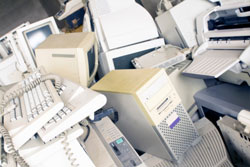by Don Willmott
As a combination technophile and neat freak, I've long been interested in the subject of e-waste. Every year Americans toss out tens of millions of cell phones, TVs, computers, and other gadgetry, and they go - where? In this country, about 87 percent of the 3 million or so tons of e-waste we generate (worldwide it's 50 million tons) heads straight to the landfill, including all the toxins and precious metals it contains. How close is your local water supply to your landfill? Now might be a good time to check.
 Up to 80 percent of the rest gets shipped abroad, where armies of the world's poorest people - including children - hunch over coal-fired furnaces and melt down circuit boards to separate out the precious metals. You can see for yourself in this legendary 60 Minutes expose taped in China in 2008. Remember that anti-pollution commercial from the '70s featuring the Native American with a tear rolling down his cheek? Well, today he has more to cry about.
Up to 80 percent of the rest gets shipped abroad, where armies of the world's poorest people - including children - hunch over coal-fired furnaces and melt down circuit boards to separate out the precious metals. You can see for yourself in this legendary 60 Minutes expose taped in China in 2008. Remember that anti-pollution commercial from the '70s featuring the Native American with a tear rolling down his cheek? Well, today he has more to cry about.
More than 1,000 raw materials - flame retardants, solvents, heavy metals, plastics, gases, lead, mercury - go into our everyday electronic devices and computer technology. If you buy hardware, install it, maintain it, or "sunset it," it's worth being aware of the options you have in dispatching of it properly when its work is done.
Sadly, the e-waste problem is only getting worse, especially in the developing world. A UN report points out that the developing countries who've been most likely to import our e-junk are now making their own significant e-waste messes. China's e-waste my increase by up to 400 percent by 2020. In India, it could be up 500 percent. One optimistic spin: When e-recycling is done correctly and safely, it can be a job creation engine, though it's hard to imagine the poorest of the poor countries have OSHA-like agencies assigned to protect workers' health and safety.
Let's face the fact that as technologists: We own at least part of this problem, especially now that we're all going through the exercise of downsizing, rightsizing, virtualizing, and shrinking our data centers. When the crew comes to haul away your old equipment, where will they take it?
E-recycling is a growth industry (with some pretty compelling career paths, by the way), and as watchdog organizations such as the Basel Action Network and E-Stewards watch over it, you can do your part by seeking out responsible recyclers. One is Cloud Blue Technologies, which works with dozens of Fortune 500 companies to handle e-recycling while monitoring compliance, data security issues, and best recycling practices. As the CEO puts it, "It's not just about scrap recycling anymore. The next generation of e-waste management merges social responsibility with a professional services-oriented approach." Cheap? Probably not. Necessary? More than ever.
To close on a more upbeat note, did you know that the more than 1,000 medals awarded at the Winter Olympics contained e-waste? In fact, more than 1.5 percent of each gold medal was made with metals harvested from CRT glass, computer parts, and circuit boards. Great idea, Canada! That was very green of you.